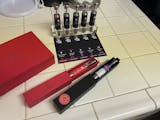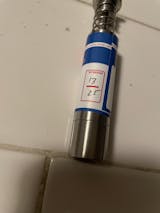If you sell dried chili peppers online, I have probably bought your peppers. Over the past two decades—and especially in the last 18 months—I’ve scoured the internet, purchasing nearly every type of pepper available from the top 30 companies in the United States. If you’re one of them, check your customer database—you’ll likely find me.
Let me be clear: I have no complaints about these companies. Their prices are fair, their shipping is quick, their customer service is responsive, and their products are generally good. But this pepper-buying frenzy wasn’t about competitive intelligence or pre-launch research for my spice company. It was something much deeper: the pursuit of the highest-quality peppers for my kits.

The Hunt for the Perfect Peppers
Over those months, I ordered dozens of varieties—Wiri Wiri, Pequin, Scotch Bonnets, 7 Pots of every color, Ghosts, Scorpions, Reapers, Anchos, and many more. Each pepper (and company) was evaluated using five criteria:
- Flavor Profile: Did it taste fresh and distinct, or was it bland and stale? Unique, bold flavors were a must.
- Heat Alignment: Each pepper needed to align with a specific spot in the 1-to-10 heat scale of my kits, climbing predictably with every number.
- Consistency and Reliability: Were batches consistent in quality? While some variation is natural, my customers expect a dependable experience.
- Pepper Form: My grinders require peppers in a flaked or crushed state—not whole pods or powders. Flakes can be ground finer, but powders seep out prematurely, ruining the experience.
- Bulk Availability: Could I reliably source these peppers in large quantities with reasonable volume discounts?
It was a grueling, costly, and painstaking process, but after 18 months, I built a library of nearly every pepper imaginable. Yet, amidst this success, an unexpected problem delayed my launch by six months and transformed the way I approach peppers.
The Scoville Dilemma: Why the Hottest Pepper Wasn’t Always Hot
If you’ve ever bought a Ghost Pepper, Scorpion, or Carolina Reaper, you’ve probably seen their Scoville Heat Unit (SHU) ratings proudly displayed. These numbers—ranging from 1.5 to 2.2 million for Reapers—represent the heat level, with the Reaper once holding the title of the world’s hottest pepper.
Naturally, my No. 10 grinder—the pinnacle of heat—would feature the Carolina Reaper. Or so I thought. But when I taste-tested Reapers from multiple sources alongside the other peppers in my kits, something surprising happened: the Reaper was rarely the hottest.
Sometimes it ranked as low as No. 7 or 8. How could the “world’s hottest pepper” consistently underperform?

Further Readings
"Pleasure from pain is uniquely human... Philosophers have often looked for the defining feature of humans — language, rationality, culture, and so on. I'd stick with this: Man is the only animal that likes Tabasco sauce."
Understanding Pepper Heat Variability
I dove into research and discovered several factors that affect a pepper's heat:
- Growing Conditions : Soil, climate, and harvest timing all play a significant role in capsaicin levels.
- Post-Harvest Handling : How peppers are dried, stored, and packaged can degrade their potency over time.
- Heat Expectations vs. Reality : The Carolina Reaper’s Guinness World Record certification in 2017 was based on a single test with an average SHU of 1.64 million, and claims of 2.2 million SHU are based on isolated, exceptionally hot peppers—not what most people will experience with typical batches.
Realizing that subjective taste tests couldn’t provide the consistency I needed, I decided to invest in technology to measure capsaicin content accurately. Using a cutting-edge voltammetry system developed in Denmark, I built a small testing lab, trained myself on the equipment, and validated my findings with a third-party lab using HPLC, the gold standard for capsaicin measurement.

Further Readings
→Quantification of capsaicinoids in chillies by solid-phase extraction coupled with voltammetry
After testing dozens of Carolina Reapers, the results were clear: their heat is far more variable than the advertised 2.2 million Scoville Heat Units (SHU) would suggest. Lab testing consistently revealed that most Reapers fall well below this benchmark, with an average closer to 750,000 SHU. In fact, as shown in the lab results, total SHU values for Reapers ranged widely, with few samples even approaching the 1.5 million mark.
This variability isn’t just theoretical—it’s rooted in real factors like growing conditions, harvesting methods, and post-harvest handling. Capsaicin levels, the molecules responsible for heat, can fluctuate significantly based on how peppers are dried, stored, and packaged. While Reapers remain some of the hottest peppers I’ve tested, they’re occasionally outperformed by other superhots, like Scorpions or 7 Pots, in both heat and flavor.
Most companies understandably rely on published data or generic SHU ranges, as routine lab testing is expensive and time-consuming. But for SpiceQuest, precision is non-negotiable. We want every kit to deliver a consistent heat progression and an exceptional flavor experience. That’s why our No. 10 Reaper is mildly fortified with 100% natural capsaicin extract—to ensure it provides the intense heat customers expect, without compromising the pepper’s bold, signature flavor.

Introducing Our Next Limited Edition: Dragon’s Breath
As I expanded beyond the core kit, I embarked on a new journey—working directly with growers across the country to uncover rare, unique, and extraordinary peppers. These aren’t peppers for everyday kits; they’re special finds, often grown in limited quantities, meant to deliver something truly distinctive. My goal was to share these rare treasures with the world, creating exclusive, limited-edition releases for those seeking an exceptional spice experience.
One such pepper has become a true game-changer: Dragon’s Breath. Rumored to reach 2.48 million SHU, this pepper has been shrouded in fascination and controversy since its creation in Wales. Despite years of searching, a reliable source seemed out of reach—until earlier this year, when I connected with a farm in Missouri cultivating Dragon’s Breath with meticulous care.
The result? A pepper that’s as unique in flavor as it is in heat. Its fruity, bold taste is matched only by its staggering heat, with lab tests consistently showing an average of 1.5 million SHU—making it one of the hottest natural peppers I’ve ever encountered.

Further Readings
In just two weeks, we’ll unveil our third limited-edition grinder featuring Dragon’s Breath. This release captures the essence of this new journey—rare finds, grown with care, and crafted to elevate your spice experience. Stay tuned for more about this remarkable pepper and the passionate growers behind it.



